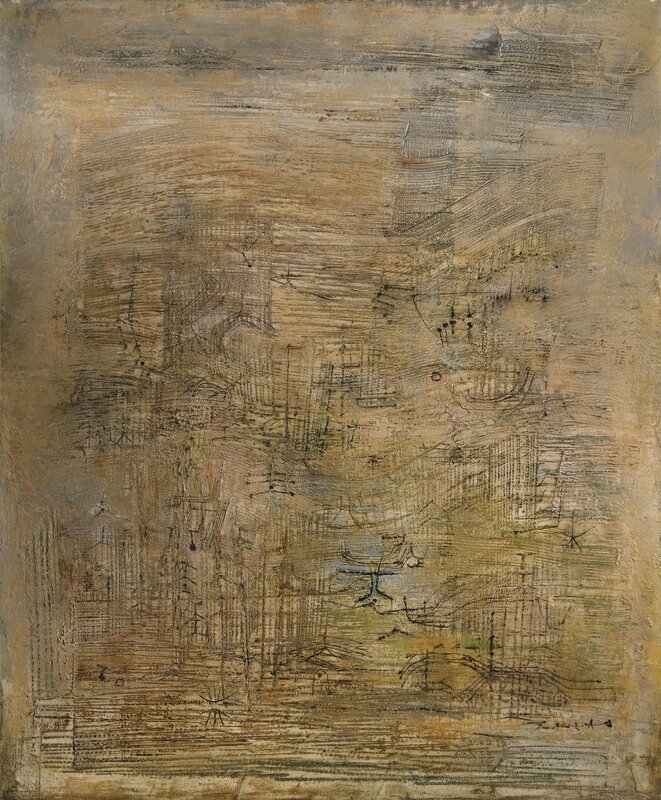Zao Wou-Ki (Zhao Wuji) (1920-2013), Forêt de bambou
Zao Wou-Ki (Zhao Wuji) (1920-2013), Forêt de bambou. Photo Sotheby's.
Signed in Chinese and Pinyin; signed in Pinyin, titled in French and Chinese and dated 1954 on the reverse. Oil on canvas, 61 by 50 cm.; 24 by 19 3/4 in. Estimate 4,000,000 — 6,000,000 HKD
Provenance: Acquired directly from the artist by the current owner
Note: This work is accompanied by a certificate of authenticity issued by Foundation Zao Wou-Ki and will be included in the artist's forthcoming catalogue raisonné by Françoise Marquet and Yann Hendgen.
As one of the greatest abstract painters in the 20th century, Zao Wou-Ki exemplified the essence of Chinese landscape paintings and Western abstract ideals, successfully paving the way to a whole new perspective on abstract painting for a younger generation of artists. While his works have shifted significantly from his early period of figurative style to the later abstract approach, landscape remains to be one of the most popular and entrancing motifs within the artist's body of work. Produced in 1954, Forêt de Bambou (Bamboo Forest)situates within one of the most crucial transitional periods in Zao's oeuvre. It represents the year in which the artist aesthetically returned to his roots in Chinese tradition, but more importantly, it was when he abandoned the final traces of figurative elements in favor of purely abstract visual language.
Born in Beijing in 1920, and schooled at the School of Fine Arts in Hangzhou, Zao had already mastered the art of calligraphy when he first arrived to Paris. However, it was truly in the years spent in Europe when the artist found his true calling in mastering the abstract art form. Zao intensively studied the works by other Europeans masters at the time, including Picasso, Matisse, and Cézanne. Among all these inspirations, it was the Swiss painter Paul Klee who was frequently cited by Zao as the one artist whose abstract works he always felt the closest with.Forêt de Bambou (Bamboo Forest) is highly imbued with transient and pictographic elements, and is essentially one of Zao's most representative works inspired by Klee. In 1951, Zao was stunned by the vast collection of drawings that he saw at a museum in Bern, Switzerland. He began to move away from figurative style and instead devoted the next few years to experimenting with lines, the deconstruction of real-life images, and the inclusion of Eastern aesthetics language. As he ultimately commented on his works during this period, "My painting[s] became unreadable, still-lives and flowers no longer existed. I was tending towards an imaginary, indecipherable writing."1
Consisting of an earthly colour palette, the lot on offer stands exceptionally apart from Zao's other oil painting works during the same year.It exudes a rare quality of calmness and quietude that evokes the artist's meditative state of mind just before he embarked onto the immensely powerful abstract phase of his later years. On view is what appears to be a rendering of a forest, void of any apparent animal or plant figuration. Straight and twisted lines dance together, and are intertwined above layers of brown and green brushwork across the canvas surface, skillfully presenting an ideographic rendering of a traditional landscape. When looked upon more closely, thin clear layers of diluted varnish can be seen to create a sense of nuances, not only providing depth to the overall composition, but also exuding a poetic ethos representative of Zao's works from the early 1950s. The reproduction of landscape as seen in this work precisely attests to the statement by Henri Michaux on Zao's works: "Revealing while disassembling, breaking the direct line or making it tremble, musing and tracing the detours of the rambling and the spidery scrawl of the dreaming mind, that is what Zao Wou Ki loves, and suddenly, with the same festive air that enlivens Chinese villages and country scenes, the picture appears, quivering joyfully and somewhat comically in an orchard of signs."2
1 "Recent Works by Zao Wou-ki", Marborough New York
2 Refer to 1
Sotheby's. Boundless: Contemporary Art. Hong Kong | 23 Jan 2014 - http://www.sothebys.com

/https%3A%2F%2Fprofilepics.canalblog.com%2Fprofilepics%2F1%2F0%2F100183.jpg)
/https%3A%2F%2Fstorage.canalblog.com%2F03%2F02%2F119589%2F96711876_o.jpg)
/https%3A%2F%2Fstorage.canalblog.com%2F11%2F31%2F119589%2F94773502_o.jpg)
/https%3A%2F%2Fstorage.canalblog.com%2F20%2F83%2F119589%2F94772815_o.jpg)
/https%3A%2F%2Fstorage.canalblog.com%2F26%2F72%2F119589%2F75604929_o.jpg)
/https%3A%2F%2Fstorage.canalblog.com%2F59%2F60%2F119589%2F26458628_o.jpg)



/http%3A%2F%2Fstorage.canalblog.com%2F33%2F75%2F119589%2F129356004_o.jpg)
/http%3A%2F%2Fstorage.canalblog.com%2F47%2F97%2F119589%2F126822262_o.jpg)
/http%3A%2F%2Fstorage.canalblog.com%2F26%2F48%2F119589%2F126810549_o.jpg)
/http%3A%2F%2Fstorage.canalblog.com%2F14%2F85%2F119589%2F126757993_o.jpg)